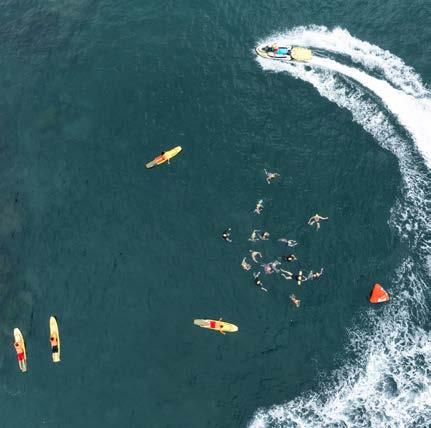




Wollongong Art Gallery to host folk-inspired music this Saturday


City Strings is collaborating with community gamelan ensemble
Steel City Strings is collaborating with community gamelan ensemble Suwitra Jaya for part of this concert inspired by folk music traditions from around the world including Australian composers Peter Sculthorpe, Gerard Brophy and Christopher Sainsbury.
For bookings scan the QR code or go to: steelcitystrings.com.au/events-calendar/
Bowral Memorial Hall, Sun 9 March 2.00pm Wollongong Art Gallery, Sat 15 March 7.30pm
Berry School of Arts, Sun 15 March 2.00pm
Suwitra Jaya for part of this concert inspired by folk music traditions from around the world, including Australian composers Peter Sculthorpe, Gerard Brophy and Christopher Sainsbury. The music
honours its origins while connecting with the rich tapestry of past traditions. A particular treat will be the haunting strains of a Balinese gamelan orchestra. There will be performances at Wollongong Art Gallery (Sat 15 March 7.30pm) and Berry School of Arts (Sun 15 March 2pm). Tickets $15-$65 online.
Tickets $15 – $65 Group of 5 or more $40 per person
Celebrating Port Kembla’s DIY skatespace

The Port Kembla DIY skatespace is set for a transformation, thanks to the efforts of its local community. Spearheaded by the Port Kembla Chamber of Commerce and Industry (PKCCI), plans for a permanent skatespace have taken a significant step forward. Local resident Will Mitry, project manager representing PKCCI, expressed his enthusiasm for
the community’s next chapter. “This marks an exciting time for Port Kembla. The new skate facility and accompanying basketball court will serve as a community hub for generations,” Mitry said. The community is invited to the PKDIY Renewal Jam on March 16th at 2pm, followed by a skate video premiere at The Servo from 5pm.

By Tyneesha Williams

Wollongong’s 2025 Young Citizen of the Year is Jack Brown, the director of mental health and suicide prevention charity Talk2MeBro.
“I’ve been part of Talk2MeBro since it first started in 2018,” Jack says.
“I lost my cousin, who was like a brother to me, to suicide that year. From there, his amazing wife Kristy created the slogan ‘Talk to me bro’.
“She took a step back about four or five years ago and since it started, we’ve built programs and workshops that we take to schools and workplaces. Now we’ve reached over 85,000 people.
“What started in Wollongong has gone on to be all over Australia.”
While the charity continues to raise mental health awareness, with the
aim of ending suicide in Australia, Jack is in his third year studying psychology at UOW after serving in the army for 10 years. He works full time at Open Arms, providing support for veterans.
“I saw that there was a gap,” Jack says of his Talk2MeBro advocacy.
“I didn’t feel like there was much for guys… like a community where you can just come down and chat.
“A lot of that sort of thing was centred around going to the pub and stuff, which I can still get around, but there was just nothing positive.
“So we started a group on Friday mornings for everyone to come down to the beach and have a swim and a coffee. Just a place to check in and have a

“We try to be the prevention rather than the cure – the pre-vention instead of the post-vention”
–
Jack Brown of Talk2MeBro
conversation about where you’re at with just a couple of dudes.”
Jack’s meet-ups have grown from a couple of men to upwards of 30 men who regularly attend Wollongong groups, with women-led women’s groups available too. Talk2MeBro groups have formed country-wide, with meet-ups in Newcastle, Canberra, south-west Sydney and central NSW.
“We run community catch-ups which are open to everybody in the community – guys, girls or anyone. We run workshops and go into schools, workplaces, gyms, and educate people around how to have tough conversations and how to take care of ourselves.
“We’re trying to empower and educate, which is going to help people in the future when they might come across someone who is struggling, or themselves.
“We try to be the prevention rather than the cure – the pre-vention instead of the post-vention.”
Jack – who wasn’t able to attend the City of Wollongong Awards ceremony on February 6, so his mum accepted the award on his behalf – is humbled to be Wollongong’s Young Citizen of the Year.
“Even though it is nice to be recognised, I don’t think you should do stuff for recognition,” Jack says.
“The organisation was started with the idea that we would be happy if we helped
one person or a thousand, and we’ve done that and we’ll continue our mission to help people, learn from our mistakes and get better as we keep getting bigger.”
Talk2MeBro has five fundraising galas planned for 2025, with one in Wollongong on September 20. This year, Talk2MeBro will be sponsored by the Illawarra Hawks and the Illawarra Dragons.
“Funding is something we’re desperately needing because of how many communities we’re in now. We’re completely community funded as an organisation, we’re not government funded,” Jack says.
“All of our community events are free, you don’t pay for anything. We’ve done that because a lot of times, financial hardship goes hand in hand with suicide. So we wanted to mitigate that by having everything be free.
“You can be struggling and come along, you don’t need to have any prerequisites, just come along to an event and you can get the support that is needed. The way that people can support us is when we have our fundraisers, come along. Whether you want to sponsor us or buy a ticket to one of our galas, or share our stuff on socials, it’s all appreciated and it helps us out.”
Below: Jack Brown with Lord Mayor Tania Brown (no relation).
Photos: Chris Frape/WCC and Tyneesha Williams

By Amanda De George

“There’s just no way we’d find the amount of interesting things that we find … without drones”
– Ashley Sykes
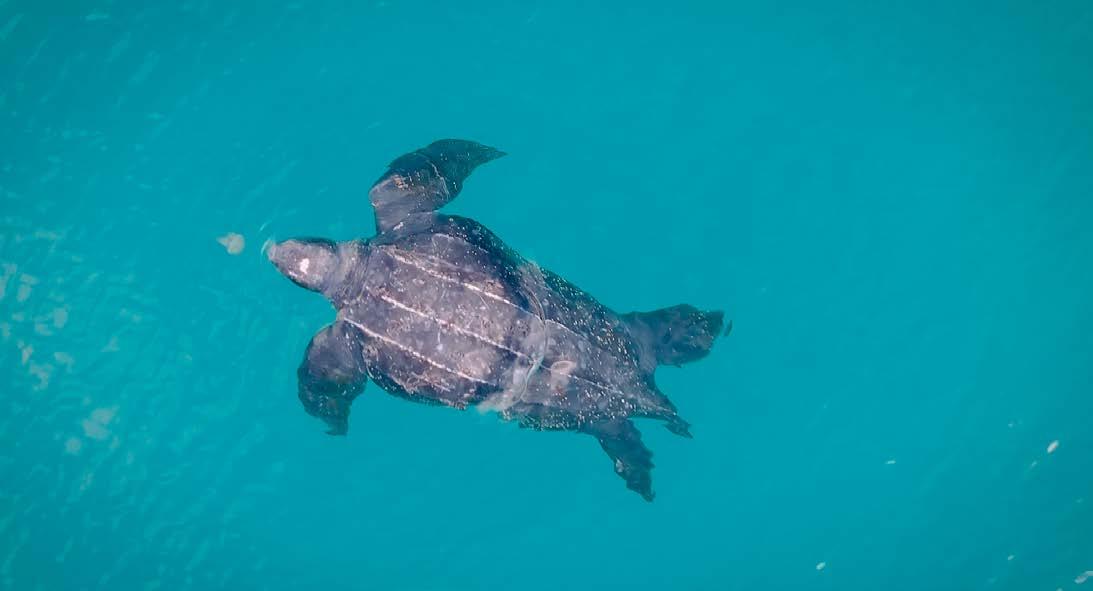
Droneshave really changed nature photography. Well, they have for some. I find it hard enough to keep the things in the air, let alone find sea creatures in an enormous expanse of water, all the while dealing with battery warnings and the inevitable wind.
But for talented drone operators like Ashley Sykes, capturing stunning footage is only part of the appeal. Over the past couple of weeks, Ashley has filmed two leatherback turtles feasting on large swarms of jellyfish. Not only are these animals listed as endangered but they’re rarely seen this far south.
“The first one I just completely randomly stumbled across at one of the beaches I go to regularly to try and find wildlife… I knew immediately what species it was because it’s quite a recognisable shape,” Ashley said.
In one of those strange coincidences that social media opens up for us, Ashley had randomly come across a Sydneybased drone operator who had filmed a leatherback turtle weeks earlier.
“Initially I assumed that it would probably be the same one [turtle] because that seems logical,” Ashley explained. “But once I compared the images of the one that the other person spotted and the one I spotted, they were definitely two different turtles.”
Considering their endangered status and their generally accepted distribution, sighting two turtles over a couple of weeks would be significant in itself but
Ashley went on to discover another unique individual, off the same Illawarra beach, a couple of days later.
So why are they this far south? Ashley has a few theories. “There’s a lot of jellyfish off the beach at the moment, like loads… so I definitely think they’d come down to eat jellyfish. And also the water at this time of year is not only the warmest it normally is but I think it’s also been unseasonably warm as well.”
He also suggests another theory, one that has backing in a recently published study. While previous information suggests that leatherback turtles are rarely seen south of tropical waters, Occurrence of leatherback turtles around Australia suggest that the species is found around the country, throughout the year and has a wider distribution than previously reported.
Ashley said: “I think that [the previously reported low numbers] is because until the last five or 10 years we didn’t have drones out, looking there.
“Those two turtles that I found would never ever have been noted otherwise.
“No one would have seen them. There’s just no way we’d find the amount of interesting things that we find and wouldn’t have the ability to understand that they are here and maybe more commonly than we think they are, as no one’s going to be coming across those things in the middle of the ocean, without drones.”
You can follow Ashley on Instagram.

Steel City Strings is collaborating with community gamelan ensemble Suwitra Jaya for part of this concert inspired by folk music traditions from around the world including Australian composers Peter Sculthorpe, Gerard Brophy and Christopher Sainsbury.
Bowral Memorial Hall, Sun 9 March 2.00pm
Wollongong Art Gallery, Sat 15 March 7.30pm Berry School of Arts, Sun 15 March 2.00pm
For bookings scan the QR code or go to: steelcitystrings.com.au/events-calendar/

Tickets $15 – $65 Group of 5 or more $40 per person

Renovated and well-equipped meeting rooms and office space in the village centre. Enquire now for availability.
26A Walker St, Helensburgh Phone 02 4227 8181 wollongong.nsw.gov.au/centres

By Andy Lawrence

Today, I’m bringing you an unassuming, juicy little sea snail that is very common on the rock shelves and pools of the Illawarra coastline. The mulberry whelk, Tenguella marginalba
This little whelk is appropriately named for the shell’s black nodules and contrasting furrows that give it a berry-like appearance. They are roughly the size of a mulberry too, growing to a maximum of three and a half centimetres.
Although they are sweet looking, mulberry whelks are predators in the intertidal zone of north and eastern Australia. They use a hard, file-like modified tongue called a radula to bore a hole into other molluscs. As they bore into the shells of their prey with their
radula, mulberry whelks release sulfuric acid-laced saliva to hasten the erosion of the calcium carbonate that composes the shell. Their favourite prey tend to be oysters and limpets, as well as barnacles, if the former two aren’t available on the menu.
The mulberry whelk shares its habitat and eating habits with another common snail, the cart-rut snail. But unlike the cart-rut snail, which ranges away from the rock shelves in search of prey, mulberry whelks stay and forage in the safety of their home in the rock crevices and cracks.
The snails are able to stay in their cosy nooks even at low tide when the rock dries out, due to the presence of a leathery operculum, otherwise known as
the snail’s front door. You’ll also see mulberry whelks in estuarine environments, where they tend to cause problems for oyster farmers by boring into the oysters and eating them before they can be harvested for our own plates.
I love a good taxonomy story and as I researched the mulberry whelk, two different genus names kept popping up: Morula and Tenguella
FYI, taxonomy is the practice of classifying and naming species and species groups. The genus is the first part of the scientific name describing a group of similar species, like Homo for humans, and the species name, sapiens, is the second part of the scientific name, describing a single species.
A little digging and I found out why there were two different names coming up for this one little snail.
The snail was originally described in 1832 by a guy called Henri-Marie Ducrotay de Blainville who, besides having a long-winded name, was a failed painter-cum-comparative anatomist who was trained by taxonomy royalty: Cuvier and Lamarck. Then in 1965, the genus containing the mulberry whelk species was delineated and named Tenguella
Another taxonomist came along in 1985 and synonymised the genus Tenguella with the genus Morula (from
the Latin morus, meaning mulberry). Taxonomic names regularly go through changes and revisions as new information or new species come to light. Since the advent of ‘DNA barcoding’ (a method of classifying species based on their individual genetic signatures) in the 90s, genetic data has greatly impacted the field of taxonomy.
In 2013, researchers studied the genetic signatures of 52 similar species within a subfamily of whelks (1). The researchers found that the whelks classified as Tenguella, then merged with Morula were, in fact, a genetically distinct group, despite a lack of morphological distinction. In the taxonomic equivalent of a dog chasing its tail, the group of seven species, including our mulberry whelk, had their genus name reinstated to Tenguella
So there you have it, the little mulberry whelk you’ve probably walked over countless times is a 200-year-old taxonomic puzzle!
1. Martine Claremont, Roland Houart, Suzanne T. Williams, David G. Reid, A molecular phylogenetic framework for the Ergalataxinae (Neogastropoda: Muricidae), Journal of Molluscan Studies, Volume 79, Issue 1, February 2013, Pages 19–29, doi.org/10.1093/mollus/eys028
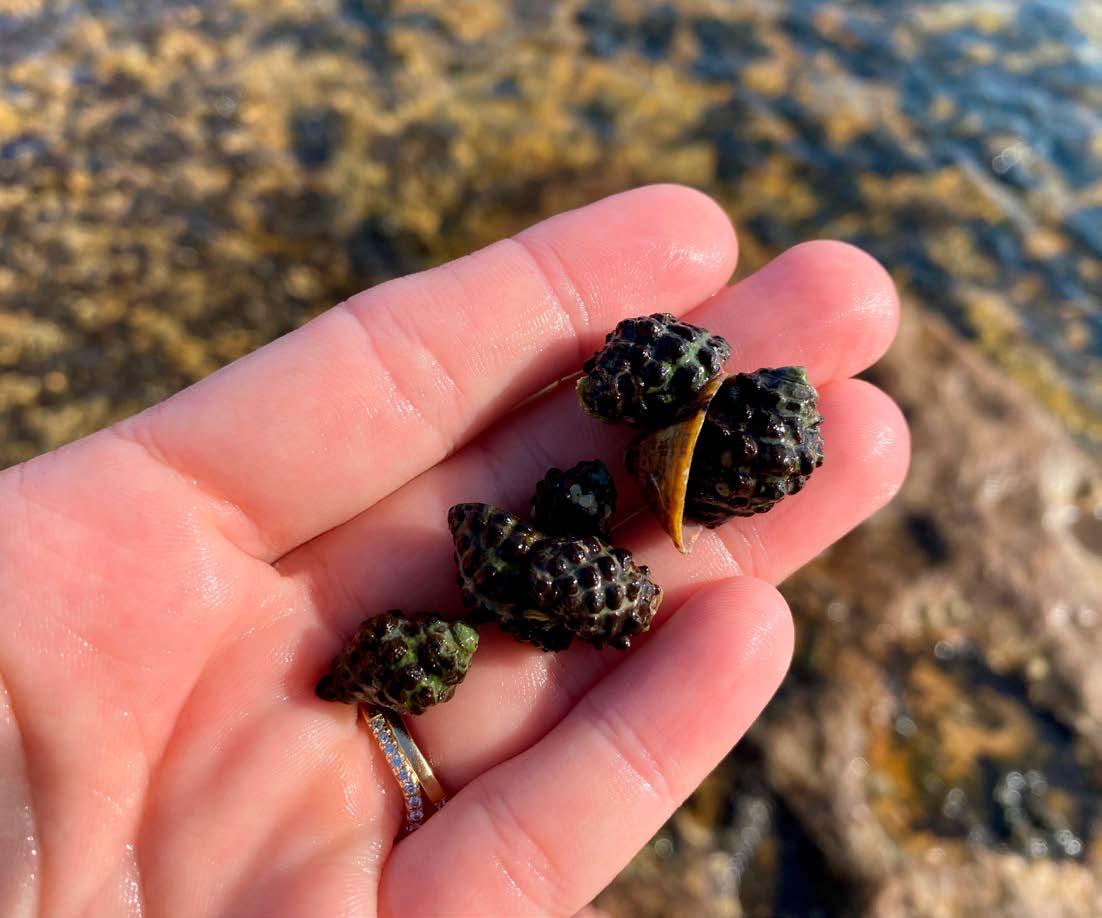
“Although they are sweet looking, mulberry whelks are predators in the intertidal zone of north and eastern Australia.”
– Andy Lawrence
By Jeremy Lasek
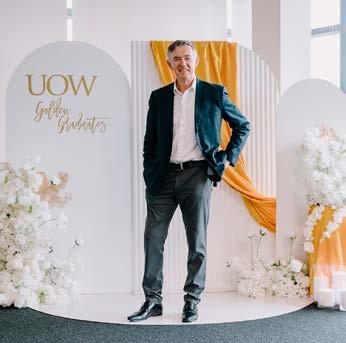
“More than 100 alumni from the university’s earliest years came to a high tea to be honoured and celebrated for their achievements and contributions”
Facingdire financial challenges, in recent times the University of Wollongong (UOW) hasn’t had a lot to celebrate. But that is changing, starting this week as the campus begins its celebrations of 50 years as the region’s leading educational institution.
As the academic year begins, the thousands of students returning to campus are being greeted by 50th anniversary flags, signage and merchandise celebrating five decades of learning. To mark the milestone, a calendar of events has been announced celebrating UOW’s achievements and highlighting the people and the community who have been integral in the organisation’s success.
On Tuesday, at the Innovation Campus, more than 100 alumni from the university’s earliest years came to a high tea to be honoured and celebrated for their achievements and contributions to the university community, professions and UOW’s legacy over the past 50 years.
Greg Evans, a UOW alumni from the class of 1977, shared his memories of a big New Year’s Eve party to celebrate the creation of the university as an independent institution in its earliest years. Tuesday’s event also featured a photographic display of iconic archival images spanning the university’s 50-year history.
Year-long anniversary program released Launching this month, 50 Voices will share the stories of the people who have shaped UOW – from the lake to the library to the lawns. The multimedia project will share the stories of staff, students, alumni, volunteers and community members about how UOW has shaped their lives, and how they in turn have contributed to UOW.
From July to December the UOW Gallery will present 50 Artists: 50 Years showcasing works by 50 nationally and internationally recognised artists affiliated with UOW.
The 50th Anniversary Awards and Gala on 12 September will be a chance to celebrate UOW’s impact on teaching, education. research and innovation over the past five decades and acknowledge the achievements of UOW’s graduates.
Adam Gilchrist to feature at MND fundraiser
Wrapping up the year of celebration, on 25 October the Wollongong campus will host a Celebrity Cricket Match to raise funds for Motor Neurone Disease research, featuring UOW ambassador and former Test cricket star Adam Gilchrist alongside local sports stars and personalities.


By Amanda De George

Workingin steel, local artist Danny Ivanovski has transformed it from an element of destruction to creation in his series exploring the history of a rainforest tree.
“My final sculpture is a red cedar tree stump that I fabricated by cutting, bending, and heat-treating the mild steel.
This was the very material that was used by the Cedar Getters to cut down these trees,” he said.

Black Summer at Sculpture in the Garden 2023 and for Dangling in the Wind at the Nan Tien Temple. His work Wondering Through the Mist, which used handmade ochre and charcoal ink, was a finalist in the Fisher’s Ghost Art Award and the Goulburn Art Award.
Danny on Instagram
Titled In Memory of Red Cedar, his thought-provoking piece has been selected for 2025’s Sculpture in the Garden exhibition, which opens at Wollongong Botanic Garden in April.
Danny is no stranger to commendation. He won the People’s Choice Award for his work Memorial for
Danny is a multi-media artist working in steel sculpture, photography and landscape painting and drawing. At the heart of his work, and even in some of his work through natural pigments that he has collected from the local environment, is his own deep connection to nature and the landscape.
“I’ve always had a deep passion for being a good steward for our natural environment,” Danny said.
“For me, the landscape is not
something to use or exploit but rather I have a connection with it. It’s part of who I am in the place where I live, therefore I want to respect and care for it.”
Creativity has always been a part of Danny’s life; he fell in love with art at the age of three and decided to pursue a career as an artist in Year 7. Nowadays he works as a Visual Arts Teacher.
“Just as my high school teachers and university lecturers nurtured my passion for the arts, I too am dedicated to helping young people develop their own creative talents and discover their own artistic voice,” Danny said.
There’s a certain balance he needs to find in creating many of his pieces. In Memory of Red Cedar is a tribute to the magnificent trees that once thrived in local rainforest.
“Their loss forever changed the Illawarra landscape, so I felt moved to reflect on this history through research and art-making,” he said.
To connect with the red cedars, Danny walked through the Illawarra
escarpment, photographing where they once stood. “I would often imagine the towering presence of the red cedar trees that once dominated the landscape but are now lost.
“That sense of absence moved me to create a memorial in the form of a red cedar stump. I felt moved to acknowledge their significance to invite us to reflect on how the Illawarra landscape has changed.
And while that loss could be overwhelming, Danny said he finds real wellbeing benefits from being surrounded by nature as he conducts research for his projects.
“Being out in nature and observing the landscape has a huge impact on my overall wellbeing. It allows me to slow down, pause and reflect on the beauty of the Australian landscape, especially here in the Illawarra where I live and work.
“Through my art, I hope to encourage others to reflect on their own connection with the landscape, the importance of caring for it and the impact that it has on our wellbeing.”

“My final sculpture is a red cedar tree stump that I fabricated by cutting, bending, and heat-treating the mild steel. This was the very material that was used by the Cedar Getters to cut down these trees” – Artist Danny Ivanovski
By Emma Rooksby, coordinator of Growing Illawarra Natives

Right across the Illawarra, in urban parks and reserves, bushland patches and even in gardens and on verges, endangered species and ecological communities live among us.
Our urban and peri-urban spaces are habitat for the Koala, first recorded by Europeans at Mount Kembla (Djembla) and the Grey-headed Flying Foxes that fill the night sky above us, for the Magenta Cherry tree and the tiny Illawarra Greenwood orchid. Depending on how you measure, there are up to 40 threatened species and about 20 threatened ecological communities (collections or assemblages of different plants and animals) in the Illawarra region. This means we all have an important role to play in helping to protect our threatened species and ecological communities.
One local threatened ecological community was on display earlier in
March, when the NSW Department of Climate Change, Environment, Energy and Water (DCCEEW) launched a new conservation program, Guardians of the Grassy Woodlands.
This new program focuses on protecting and restoring Illawarra Lowlands Grassy Woodland, a threatened ecological community that basically occurs only in our region (though recent redefinitions have seen it extend south as far as Bawley Point).
Only 12% of the ecological community remains. It has been extensively cleared for timber, agriculture, grazing, housing and community infrastructure.
And yet it’s absolutely enchanting, full of pretty little flowering plants, interesting mistletoes and a wealth of native fauna.
At the project launch at Dapto Ribbonwood Centre, the Saving Our
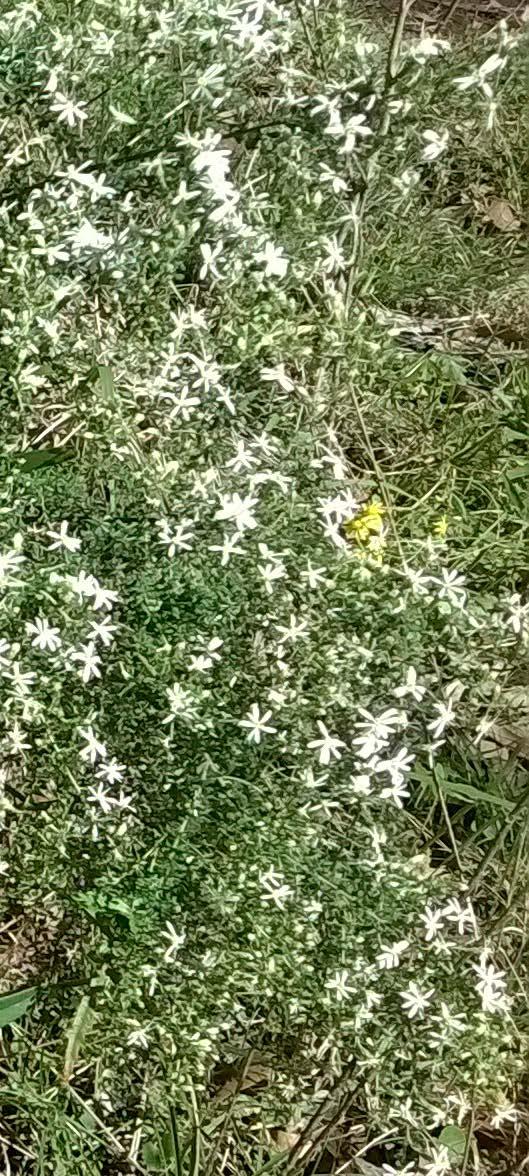
“This
new program focuses on protecting and restoring Illawarra Lowlands Grassy Woodland, a threatened ecological community that basically occurs only in our region’ – Emma Rooksby
Species team from DCCEEW introduced the Grassy Woodlands and gave the audience some useful tips on how to be a Guardian.
There are many opportunities to become involved. If you live in the Illawarra, anywhere south from Corrimal, you may be in an area that once hosted Illawarra Lowland Grassy Woodlands, or where remnant Grassy Woodlands are still present. Parts of West Dapto and Albion Park have some larger patches left on private land, while many properties in these areas, and on the coastal plain north to Corrimal, would have land that could be restored with Grassy Woodland species.
Pictured at left is the interesting, tangled and gorgeous understorey of the Illawarra Lowlands Grassy Woodland, with the beautiful climber Purple Coral-pea (Hardenbergia violacea) twining in among delicate Bridal Daisy-bush (Olearia microphylla). Many exquisite combinations of colours and textures can be found.
Actions to take as a Guardian of the Grassy Woodlands include:
• Grow local native species in your garden, verge or local patch: avoid exotic species and Australian cultivars such as Grevillea cultivars that attract
aggressive Noisy Miner birds.
• Let your patch rewild itself: stop removing fallen leaves and sticks, and let them create habitat where they fall in your garden
• Prevent garden plants from escaping into nearby bushland; many garden plants, including some commonly grown fruits and vegetables, are potential weeds.
• Join the new Guardians of the Grassy Woodlands project. You can contact the Guardians team at DCCEEW to find out more or get involved at sethreatenedspeciesteam@ environment.nsw.gov.au. At present the team is doing baseline surveying for local microbats (which are some of the cutest critters going), and looking for properties with Grassy Woodlands to survey.
Below: One of the many little ‘pretties’ of the Illawarra Lowlands Grassy Woodland, this Tick Trefoil (Desmodium gunnii, though recently changed to Pullenia gunnii) is a low-growing twiner with clover-like leaves and divine little pink flowers in spring and summer. All photos: Emma Rooksby

2025’s Yours & Owls festival was held at Wollongong’s Flagstaff Hill on March 1 and 2. Photos: Tyneesha Williams


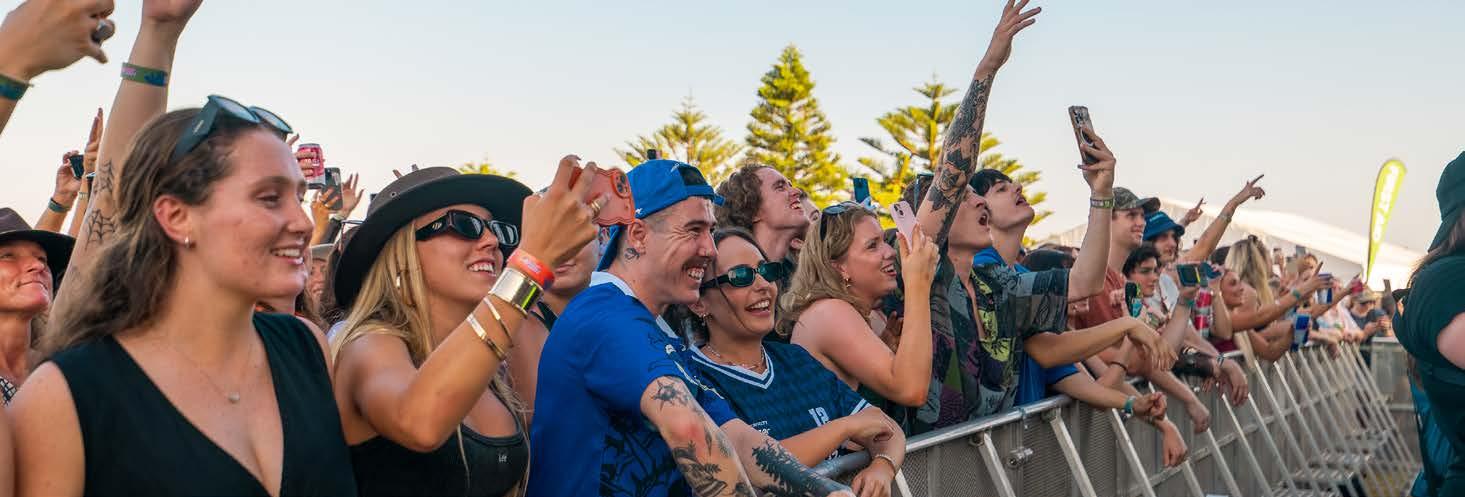








On March 1 and 2, Yours & welcomed 30,000 punters to its prime new location at Wollongong’s Flagstaff Hill. Windang-born band Hockey Dad were back, a decade after playing at the first Y&O festival, alongside headliners, Denzel Curry, The Kooks, Fontaines D.C. and The Goo Goo Dolls. The event also included the first government-run pill testing trial in Australia. NSW Health provided the free service and 100 patrons used it.

By Jeremy Lasek

The big news on the Wollongong restaurant scene this week is that one of the city’s most popular Italian restaurants, Cosa Nostra, is on the market.
After decades, cooking and serving meals in Wollongong, Cosa Nostra owners Neve and Giorgio Piras have decided it’s time for a well-earned rest.
Their journey is a classic Wollongong migrant story. In Italy, Giorgio was a policeman and Neve an arts academic.
Migrating from Puglia in the early 1970s, like so many others, their life in the Illawarra started in the Fairy Meadow migrant hostel.
While Giorgio worked at Transfield,
Neve’s first experience working in the food business was nearly 50 years ago at Pizza Roma in Crown Street.
She opened her own pizza restaurant, Il Faro, in Kembla Street and operated it for a decade before selling and taking a long holiday visiting family and friends in Italy.
On her return, Neve worked at the Italian Centre in Stuart Street for seven years before buying her own pizzeria in lower Crown Street which they named Cosa Nostra.
They kept that name when they relocated to the restaurant’s current site in Corrimal Street’s busy dining strip 16 years ago.
Over the years, Neve, Giorgio and their son, Peter, have built a reputation for operating a welcoming family restaurant, serving high-quality Italian classics.
Neve says their most popular dishes are spaghetti marinara and veal milanese “because nobody makes it anymore”.
The cosy 50-seater has so many stories to tell but perhaps the standout is son Peter’s battle with leukaemia.
Peter has had a long-time interest in racehorses and his health was deteriorating when he became the part-owner of champion racehorse Redzel.
“Peter was very, very sick but that horse gave him a new life,” Neve said. “Any chance to get to Sydney to visit the horse and Peter was there. He called Redzel his daughter.”
Redzel became one of the most successful horses of the past decade, winning more than $16 million in prize money. In 2017 he was the inaugural winner of the world’s richest turf race, The Everest, collecting first prize money
of $5.8 million. The following year Redzel led all the way to win the second running of The Everest, collecting a $6 million purse.
“The money was wonderful, of course, but that horse meant so much more to Peter. It made a huge difference to his life,” Neve said.
The restaurant still sells Redzel memorabilia, with money raised going to leukaemia, transplant and children’s charities.
At 74, Neve says she and Giorgio, 78, have been thinking of selling up for some time.
“My life is here but it’s time for a rest,” Neve said. “It will be a very sad day when we finish. I love my customers. They’re not customers, they’re friends. Like a family.”
Once the sale is finalised. Neve and Giorgio plan to visit Italy “one more time” and enjoy more time in their garden.
Cosa Nostra at 114 Corrimal Street, Wollongong has been listed for sale by Comelli.

“My life is here but it’s time for a rest. It will be a very sad day when we finish. I love my customers. They’re not customers, they’re friends. Like a family.”
– Neve Piras


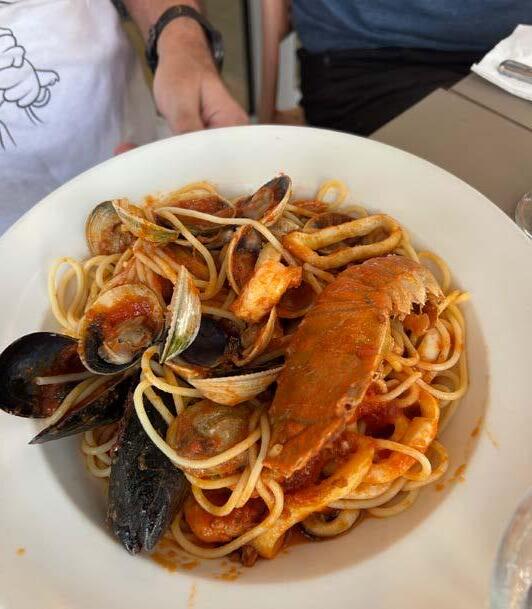
By Genevieve Swart

Across Central and West Asia, flowers are lighting up deserts, orchards and ancient cities. According to the Solar Hijri calendar, it’s almost time to celebrate an ancient spring festival –Nowruz, the Persian New Year.
“Nowruz means ‘new day’ in our language,” says Diana Ramezani of the Illawarra Iranian Association, which is planning a New Year party on Thursday, March 20 at the University of Wollongong.
“It’s the beginning of our year, it’s exactly at the beginning of spring. Right now my city, Tehran, will be bursting with blooms. It’s very beautiful.”
“Nowruz goes back at least 5000 years of recorded history, it could be even more,” says Ramin Bayani, a fellow member of the Illawarra Iranian Association.
“It’s celebrated in Central Asia, Iran, Afghanistan, Tajikistan, parts of Turkey and Iraq, out to northern India.”
Millions of people are set to rejoice in the season of rebirth, including our local community, which Ramin says numbers about 2000 people.
“Nowruz is timed with the northern spring. The year changes in tune with nature, as the trees blossom, so the year changes,” he says, recalling how his village used to light up with beautiful white apple tree blossoms.
Ramin and Diana left Iran to find better opportunities in a new country.
Ramin at age 18, set off on an adventurous journey, travelling from Tehran to western Pakistan, riding a camel through desert dunes, undertaking a risky border crossing. He sought refuge in Pakistan for 17 months, then came to Australia in 1989.
“I spent the first eight or nine years at university in Sydney,” he says.
Ramin followed his dream, graduated and became an optometrist. He moved to the Illawarra 28 years ago and now runs his own practice in Warrawong.
By contrast, Diana describes herself as a ‘newcomer’, arriving more conventionally by plane in 2023. Diana is a psychologist who now works as a multicultural support coordinator. Both Iranians value the equality and respect for human rights that they’ve found in Australia.
“But leaving home is not easy,” Diana says.
The Illawarra Iranian Association’s Nowruz event at UOW next Thursday night is a chance to come together and celebrate with traditional music, dancing and food.
“Rice with fish and herbs like parsley
and dill – that is the traditional Nowruz dish,” Ramin says.
Persian rice is hard to find locally now that Crown Street’s Iranian shop has closed. Ramin says Warrawong’s LotusMart grocers stocks rice that’s similar but for true Persian rice – which he and Diana describe as “creative, colourful and aromatic” – they’d have to travel to Sydney. For a good recipe, Diana recommends Sabzi Polo ba Mahi by Persian Mama.
Other popular dishes during Nowruz are Ash Reshteh, a thick soup with noodles, herbs, peas and beans, and Samanu, a sweet wheat dessert.
Rich in symbolism
Nowruz has evolved from an ancient spring rite to become a secular festival, recognised by the United Nations for fostering cultural diversity, peace and unity. Its origins lie in the Zoroastrian era and the ancient Persian empire. Today it is celebrated in many ways, but overall it’s a time of joy for family and friends, filled with poetry, symbolism and ritual.
In Iran, Nowruz begins with shopping and spring cleaning, the time of Khoneh Takooni, or ‘shaking of the house’. Next comes the painting of decorative eggs, representing fertility, and gathering objects for the ‘Haft-Seen’ table.
“We prepare a table with seven things that start with S in our language,” Diana says. “Each S is symbolic of one thing and the main thing is sprouts, a sign of new life.”
As well as wheatgrass, tables feature the pudding samanu (representing sweetness and fertility), vinegar (age and patience), the sweet and dry fruit of the lotus tree (love), apples (beauty), garlic (good health) and the spice sumac (sunrise and light overcoming darkness).
Traditions live on
Ramin recalls Nowruz as a time of feasting in his village, visiting one house after another, starting with his grandparents. On one night, like Halloween, kids would dress up and disguise themselves, then knock on a neighbour’s door to ask for lollies.
Diana remembers believing in a male figure like Santa, who came bearing gifts after a winter ruled by Nane Sarma
[Grandmother Frost].
“We call him Amu Nowruz, which means Uncle Nowruz. My mum always bought something for us and in the morning of the new year, when I woke up, I found my gifts and I believe that I was a very good girl so Uncle Nowruz gave me presents. It is one of my best memories.”
One tradition that’s survived millennia is jumping over a bonfire on the last Wednesday before Nowruz, symbolically shedding sickness and embracing health. It’s also said that placing a fire on the top of your house will help angels find it and bring blessings. Lighting candles is a common custom and Diana says her nana believed you should never blow them out as fire is sacred – candles should burn to the end.
Nowruz celebrations begin on the equinox, when the sun passes above the equator and night and day are equal. This year that will be at 12.31pm in Tehran, 8.01pm in Wollongong on March 20.
Bowls of goldfish – which symbolise ‘life’ – are a feature in many homes. “I remember when I was young, my dad used to tell me that at the exact moment of the changing time, the fish actually comes to the surface,” Ramin says.
Wisdom of poets
Families treasure poetry and display the works of 12th and 13th-century Persian poets Hafez and Saadi Shirazi, whose verses about humans being of one essence and soul are inscribed above the entry of a United Nations building in New York.
Renewing friendships is important, Ramin says. “Forget about past animosities and make a fresh start, wipe the slate clean. A lot of disputes get resolved on the Nowruz day.”
Nowruz runs for 13 days, ending with big family picnics outdoors.
“On the 13th day, you’re not supposed to stay home,” Ramin says, with Diana explaining that this dates from a story about the prophet Solomon and how good people left the city to find him and invite him to return.
“Everybody goes to picnic in parks – just celebrate and have fun and dance and music and food,” Ramin says.
“That caps off the Nowruz celebration.”

“We prepare a table with seven things that start with S in our language. Each S is symbolic of one thing and the main thing is sprouts, a sign of new life.”
– Diana Ramezani of the Illawarra Iranian Association
